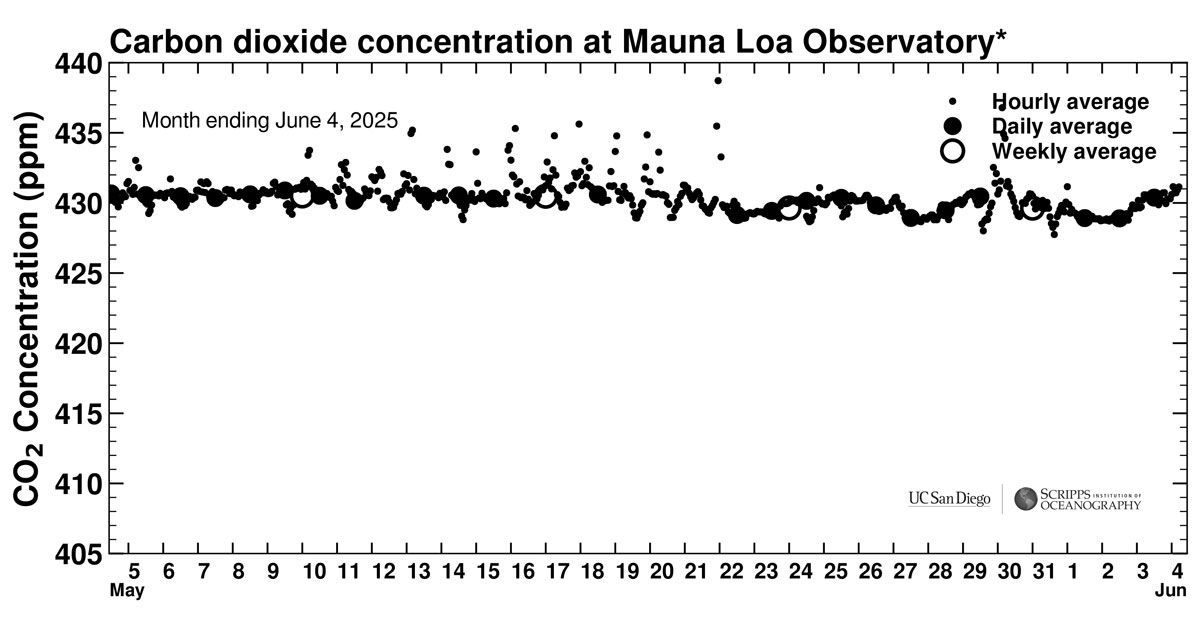Annual Carbon Dioxide Peak Passes Another Milestone
Monthly Keeling Curve average exceeded 430 parts per million in May
Story by:
Published Date
Article Content
For the first time, the seasonal peak of carbon dioxide concentrations in the atmosphere exceeded 430 parts per million (ppm) at NOAA’s Mauna Loa Observatory on Hawaii, scientists from NOAA and Scripps Institution of Oceanography at the University of California San Diego reported today.
Scripps Oceanography scientists calculated a May monthly average of 430.2 ppm for 2025, an increase of 3.5 ppm over May 2024’s measurement of 426.7 ppm. Scientists with NOAA’s Global Monitoring Laboratory reported an average of 430.5 ppm, an increase of 3.6 ppm over last year.
“Another year, another record,” said Ralph Keeling, director of the Scripps CO2 Program. “It’s sad.”
Situated high on the slopes of the Mauna Loa volcano, the Mauna Loa Observatory is the global benchmark location for monitoring atmospheric CO2. At an elevation of 11,141 feet above sea level, the observatory produces measurements that represent the average state of the atmosphere in the northern hemisphere.
In 1958, Scripps scientist Charles David Keeling, father of Ralph Keeling, began monitoring CO2 concentrations at the NOAA weather station located at the observatory site. Keeling was the first to recognize that CO2 levels in the Northern Hemisphere peaked in May, fell during the growing season, and rose again as plants died in the fall. He documented these CO2 fluctuations in a record that came to be known as the Keeling Curve. He was also the first to recognize that, in addition to the seasonal fluctuation, CO2 levels rose every year.
NOAA initiated daily CO2 measurements in 1974 and has maintained a complementary, independent measurement record ever since.
For most of the past half century, continuous daily sampling by both NOAA and Scripps at Mauna Loa provided an ideal baseline for establishing a long-term time series of the increase in the most important human-caused greenhouse gas. In November 2022, the eruption of Mauna Loa volcano buried over a mile of the access road to the observatory in lava. After a brief pause, Scripps and NOAA re-established measurements at the summit of nearby Maunakea. Later in 2023, NOAA staff accessing the observatory by helicopter installed a solar power and battery backup system that allowed them to restart CO2 measurements. A temporary road to the observatory across the lava fields is expected to be completed this fall.
Like other greenhouse gases, CO2 acts like a blanket, trapping heat and warming the lower atmosphere. This changes weather patterns and fuels extreme events, such as heat waves, droughts and wildfires, as well as heavier precipitation and flooding. Rising CO2 levels also contribute to ocean acidification, a change in ocean chemistry that makes it more difficult for marine organisms like crustaceans, bivalves and coral to grow hard, carbonate skeletons or shells.
While the Mauna Loa Observatory is considered the benchmark climate monitoring station for capturing the global rise in CO2, it does not capture the full extent of variations in CO2 throughout the atmosphere. Stations in the Southern Hemisphere have not yet crossed 430 ppm, and have a reversed cycle. NOAA’s globally distributed sampling network provides this broader picture, which allows not just tracking the overall rise, but diagnosing locations of sources and sinks of CO2, such from northern or tropical forests or the oceans. Similarly, the Scripps CO2 program operates 14 global sampling stations.
The Mauna Loa data, together with measurements from sampling stations around the world, are incorporated into the Global Greenhouse Gas Reference Network, a foundational research dataset for international climate scientists and a benchmark for policymakers attempting to address the causes and impacts of climate change.
Measurements by the Scripps CO2 program are supported by the U.S. National Science Foundation, by Schmidt Sciences, and by Earth Networks, a technology company that has collaborated with Scripps to expand the global greenhouse gas monitoring network.
Learn more about research and education at UC San Diego in: Climate Change
Share This:
Stay in the Know
Keep up with all the latest from UC San Diego. Subscribe to the newsletter today.




